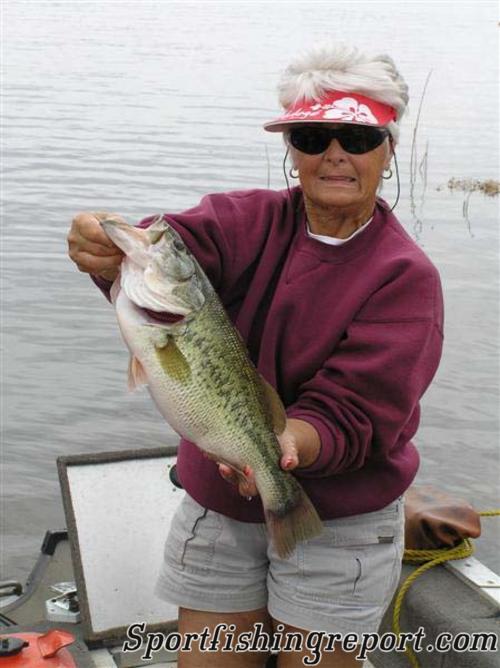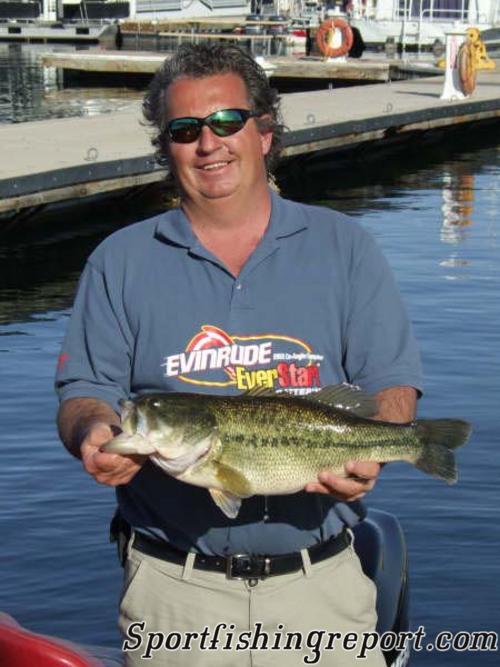Lake Powell Fish Report for 4-15-2008
Lake Powell Fishing Report
Lake Powell

by Wayne Gustaveson
4-15-2008
Website
Largemouth bass began nest construction this week as air temperature hit 80 degrees. Spawning is imminent with largemouth going first followed by smallmouth a few days later. Warming is long overdue but may work to the advantage of anglers who enjoy fishing for spawning bass. Expect to find bedding bass in shallow water for the next 10 days. Lake levels are not increasing at a quick rate so nests will be visible for the first spawn.
All of this is weather related. Bass move on nests as the water warms quickly. This spawning trigger causes a quick reaction in bass that are now overdue. Bass move on nests and spawn within a few hours. Males are actively building nests today. Each male then spawns with one to two females on the next warm day. On the third day the male drives away anything that comes close to the nest including female bass and fishing lures. Aggression is greatest right after the spawn and decreases with each passing day. By the fifth day of nest tending the male is seen lurking near the nest but not actively chasing. In warm water, eggs hatch and fry swim off in about 7 days. It takes longer if the water cools. Males stay with swimming clouds of black fry for a few days and then spawn again. Each male may make as many as 6 spawns during a season if driven off the nest by cooling temperatures. They renest as soon as the water warms once more.
It is fun to sight fish for bedding bass. Watching a slow sinking senko or grub settle onto the nest creates an adrenalin rush as the nest monster rushes to the attack. Enjoy the spectacle but return fish caught on beds so they can protect the nest. If keeping a few bass for dinner - keep the fish that are lurking on the extremities beyond the nest. In the bass community, females are excess fish and should be the ones harvested. The males are vital to perpetuate the species.
Striper fishing is excellent. In the south, stripers have moved into the main channel. It is not necessary to fight the crowd at the dam any longer. Large schools are found roaming the channel near Buoy 1 and 3 and from the Power Plant intake to Buoy 9. The points in Navajo Canyon just past the double islands are beginning to produce some nice catches. Main channel fish tend to move to a slightly different spot each day so a good method to find them is trolling the wall with a deep diving lure. When fish hit the trolling lure, stop and drop bait to fill the cooler in a hurry. With warming temperatures remember to put fish immediately in a cooler with ice to keep the fish fresh. Do not place them on a stringer in warm water. They deteriorate in a hurry unless kept cool.
In the north lake both bait and trolling are working. Moki Wall near the mouth of the canyon is producing for bait anglers, as is the mouth of Lake Canyon. Trolling with a deep diving lure like a Rapala X-Rap is working well in the back of Bullfrog Bay, Red Canyon south of Castle Butte, and White Canyon. Water is stained by runoff beginning at Ticaboo in Good Hope Bay but it is not interfering with fishing until rounding the horn at 2 Mile and 4 Mile Canyons. The backs of these canyons are still clear enough to fish.
Crappie are showing up in modest numbers around brush in the backs of many canyons. This is the best report of fishing conditions that I have been able to write this year. Watch the weather reports and plan the spring trip now. Try to fit it in between storm fronts for best results.
More Reports
Lake Powell Fish Report 04-09-2008
Lake Powell
4-9-2008
In the southern lake the big news is steady fishing for stripers along the barricade line...... Read More

Website Hosting and Design provided by TECK.net
